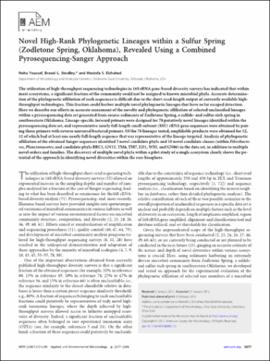| dc.contributor.author | Youssef, Noha | |
| dc.contributor.author | Steidley, Brandi L. | |
| dc.contributor.author | Elshahed, Mostafa S. | |
| dc.date.accessioned | 2018-09-21T17:51:38Z | |
| dc.date.available | 2018-09-21T17:51:38Z | |
| dc.date.issued | 2012-04-15 | |
| dc.identifier | oksd_youssef_novelhigh-rank_2012 | |
| dc.identifier.citation | Youssef, N., Steidley, B. L., & Elshahed, M. S. (2012). Novel high-rank phylogenetic lineages within a sulfur spring (Zodletone Spring, Oklahoma), revealed using a combined pyrosequencing-Sanger approach. Applied and Environmental Microbiology, 78(8), 2677-2688. https://doi.org/10.1128/AEM.00002-12 | |
| dc.identifier.uri | https://hdl.handle.net/11244/301774 | |
| dc.description.abstract | The utilization of high-throughput sequencing technologies in 16S rRNA gene-based diversity surveys has indicated that within most ecosystems, a significant fraction of the community could not be assigned to known microbial phyla. Accurate determination of the phylogenetic affiliation of such sequences is difficult due to the short-read-length output of currently available high-throughput technologies. This fraction could harbor multiple novel phylogenetic lineages that have so far escaped detection. Here we describe our efforts in accurate assessment of the novelty and phylogenetic affiliation of selected unclassified lineages within a pyrosequencing data set generated from source sediments of Zodletone Spring, a sulfide- and sulfur-rich spring in southwestern Oklahoma. Lineage-specific forward primers were designed for 78 putatively novel lineages identified within the pyrosequencing data set, and representative nearly full-length small-subunit (SSU) rRNA gene sequences were obtained by pairing those primers with reverse universal bacterial primers. Of the 78 lineages tested, amplifiable products were obtained for 52, 32 of which had at least one nearly full-length sequence that was representative of the lineage targeted. Analysis of phylogenetic affiliation of the obtained Sanger sequences identified 5 novel candidate phyla and 10 novel candidate classes (within Fibrobacteres, Planctomycetes, and candidate phyla BRC1, GN12, TM6, TM7, LD1, WS2, and GN06) in the data set, in addition to multiple novel orders and families. The discovery of multiple novel phyla within a pilot study of a single ecosystem clearly shows the potential of the approach in identifying novel diversities within the rare biosphere. | |
| dc.format | application/pdf | |
| dc.language | en_US | |
| dc.publisher | American Society for Microbiology | |
| dc.rights | This material has been previously published. In the Oklahoma State University Library's institutional repository this version is made available through the open access principles and the terms of agreement/consent between the author(s) and the publisher. The permission policy on the use, reproduction or distribution of the material falls under fair use for educational, scholarship, and research purposes. Contact Digital Resources and Discovery Services at lib-dls@okstate.edu or 405-744-9161 for further information. | |
| dc.title | Novel high-rank phylogenetic lineages within a sulfur spring (Zodletone Spring, Oklahoma), revealed using a combined pyrosequencing-Sanger approach | |
| osu.filename | oksd_youssef_novelhigh-rank_2012.pdf | |
| dc.description.peerreview | Peer reviewed | |
| dc.identifier.doi | 10.1128/AEM.00002-12 | |
| dc.description.department | Microbiology and Molecular Genetics | |
| dc.type.genre | Article | |
| dc.type.material | Text | |
| dc.subject.keywords | bacteria | |
| dc.subject.keywords | biodiversity | |
| dc.subject.keywords | cluster analysis | |
| dc.subject.keywords | dna primers | |
| dc.subject.keywords | dna, bacterial | |
| dc.subject.keywords | dna, ribosomal | |
| dc.subject.keywords | hot springs | |
| dc.subject.keywords | molecular sequence data | |
| dc.subject.keywords | oklahoma | |
| dc.subject.keywords | phylogeny | |
